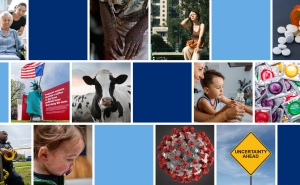Public Health Researchers Call for New Measures to Protect Pharmaceutical Supply Chain
Shortages of important drugs amid COVID-19 crisis highlights need for policy changes
Shortages of many essential drugs amid the COVID-19 crisis reveal serious vulnerabilities in the systems for supplying and distributing pharmaceuticals in the United States, according to a new report led by researchers at the Johns Hopkins Bloomberg School of Public Health.
In the report, “The Pandemic and the Supply Chain,” the researchers identify multiple problems in the drug supply chain, and then recommend specific policy actions that the Food and Drug Administration and Congress could take to reduce current drug shortages and prevent future shortages—creating incentives for more U.S.-based production of essential pharmaceuticals, for example.
In a commentary published online January 28 in the American Journal of Public Health, several report co-authors outline an agenda to address these challenges.
“The COVID-19 crisis has further exposed the vulnerability of the United States to shortages of essential drugs,” says Joshua M. Sharfstein, Vice Dean for Public Health Practice and Community Engagement at the Bloomberg School, who contributed to both the report and the commentary. “Our recommendations are meant not only to address current challenges in the pandemic, but also to improve the workings of the supply chain under ordinary circumstances.”
The COVID-19 pandemic sharply increased demand for drugs commonly used in intensive care settings. These included sedatives, which are given to patients on ventilators, and vasopressors, which help support patients who have dangerously low blood pressure—a frequent complication of severe COVID-19. Many of these drugs had already been subject to at least moderate shortages due to chronic supply chain deficiencies prior to the pandemic.
As the authors note in their report, the sudden and enormous COVID-19-driven increase in demand for such drugs was part of a perfect storm leading to shortages all the way up the supply chain, even for the basic chemical ingredients used in these pharmaceuticals.
While increased hospital demand for COVID-19-related drugs was one big factor, major disruptions on the supply side diminished supply flow. Weeks before the coronavirus reached a significant threshold in the U.S., many global factories that produce drug ingredients and drugs had already shut down. Moreover, the pandemic closed international shipping ports or greatly reduced their flow of goods, prevented Food and Drug Administration officials from inspecting manufacturing facilities abroad, and prompted some countries’ governments to restrict drug exports to preserve their domestic supplies.
At the same time, the authors argue, FDA and other organizations that are supposed to detect medical shortages did not have adequate systems in place for this purpose when the COVID-19 crisis struck. These systems performed particularly poorly in the tracking of the local shortages that soon occurred in the U.S. health care system nationwide. The authors found that the U.S. government also lacked the ability to quickly shift supplies of scarce drugs as needed to alleviate these local shortages.
The report notes that the U.S. government has already taken some steps to fix these problems, though the authors recommend further actions: FDA should expand their drug-shortage surveillance system to better track local shortages—and as part of a larger effort to set up a supply chain management system that can operate during crises. They also recommend that the FDA should create incentives for more manufacturers, especially domestic drugmakers, to get involved in producing drugs that are currently subject to shortages.
“There are multiple dimensions to the challenges facing the supply chain,” says Sharfstein. “Fixing weaknesses is both an urgent task and a necessary step to improve resilience in the future.”
Mariana Socal, MD, assistant scientist in the Bloomberg School’s Department of Health Policy and Management and a member of the Johns Hopkins Drug Access and Affordability Initiative project team, coordinated a group of faculty and students in developing the report. She contributed both to the report and the commentary.
The report, “The Pandemic and the Supply Chain: Addressing Gaps in Pharmaceutical Production and Distribution," was written by Joshua Choe, Matthew Crane, Jeremy Greene, Jingmiao Long, Joelynn Mwanga, Joshua Sharfstein, Mariana Socal, and Rachel Strodel.
The American Journal of Public Health commentary was written by Mariana Socal, Joshua Sharfstein, and Jeremy A. Greene.
# # #
Media contacts: Caitlin Hoffman at choffman@jhu.edu and Carly Kempler at ckemple2@jhu.edu.
For more information on the novel coronavirus and COVID-19, visit our COVID-19 Expert Insights site.





